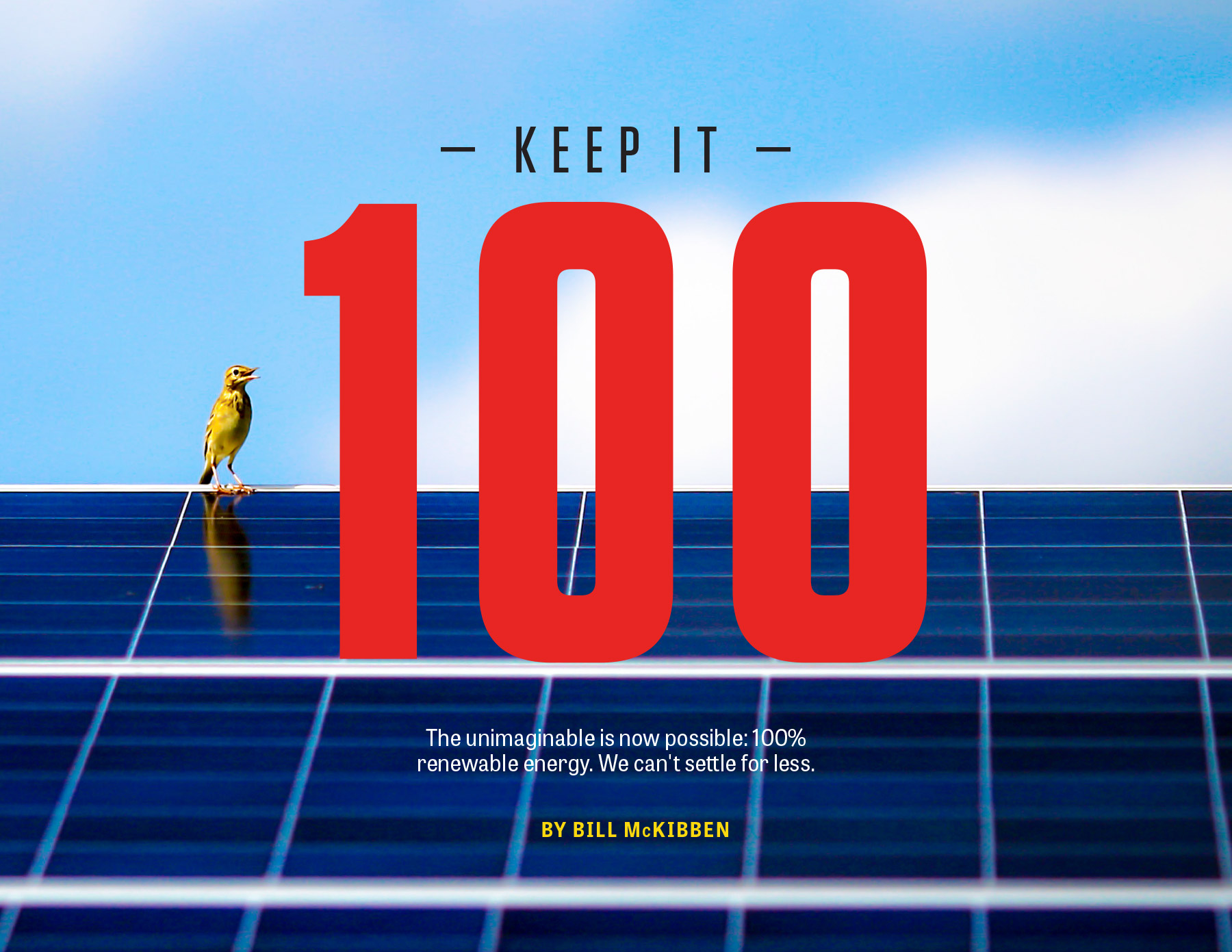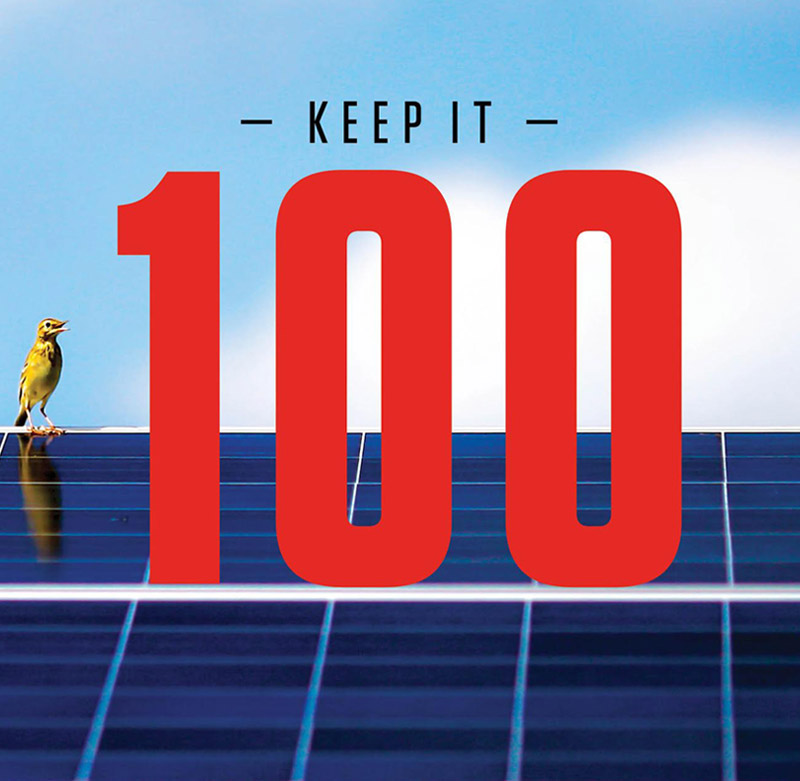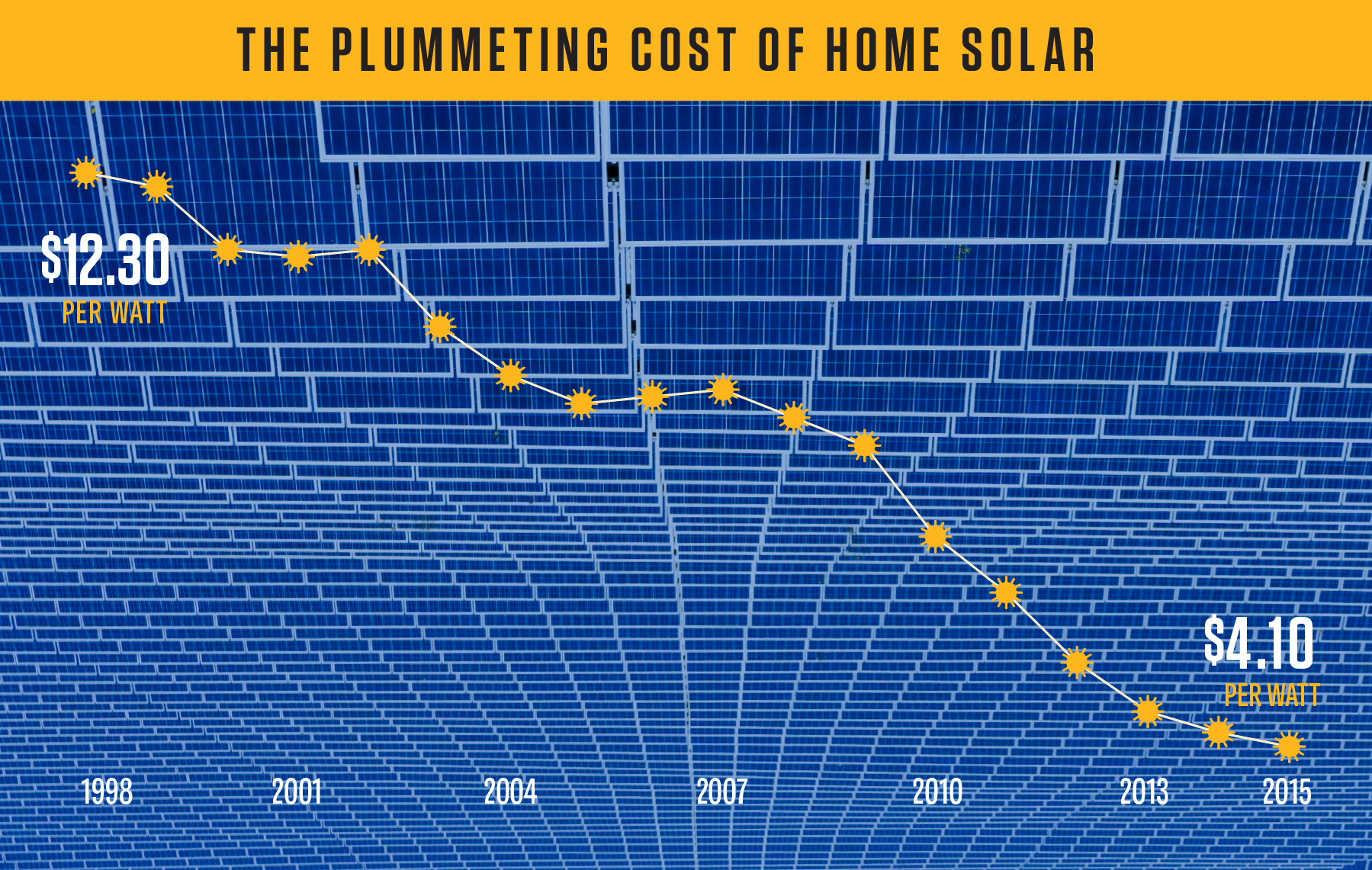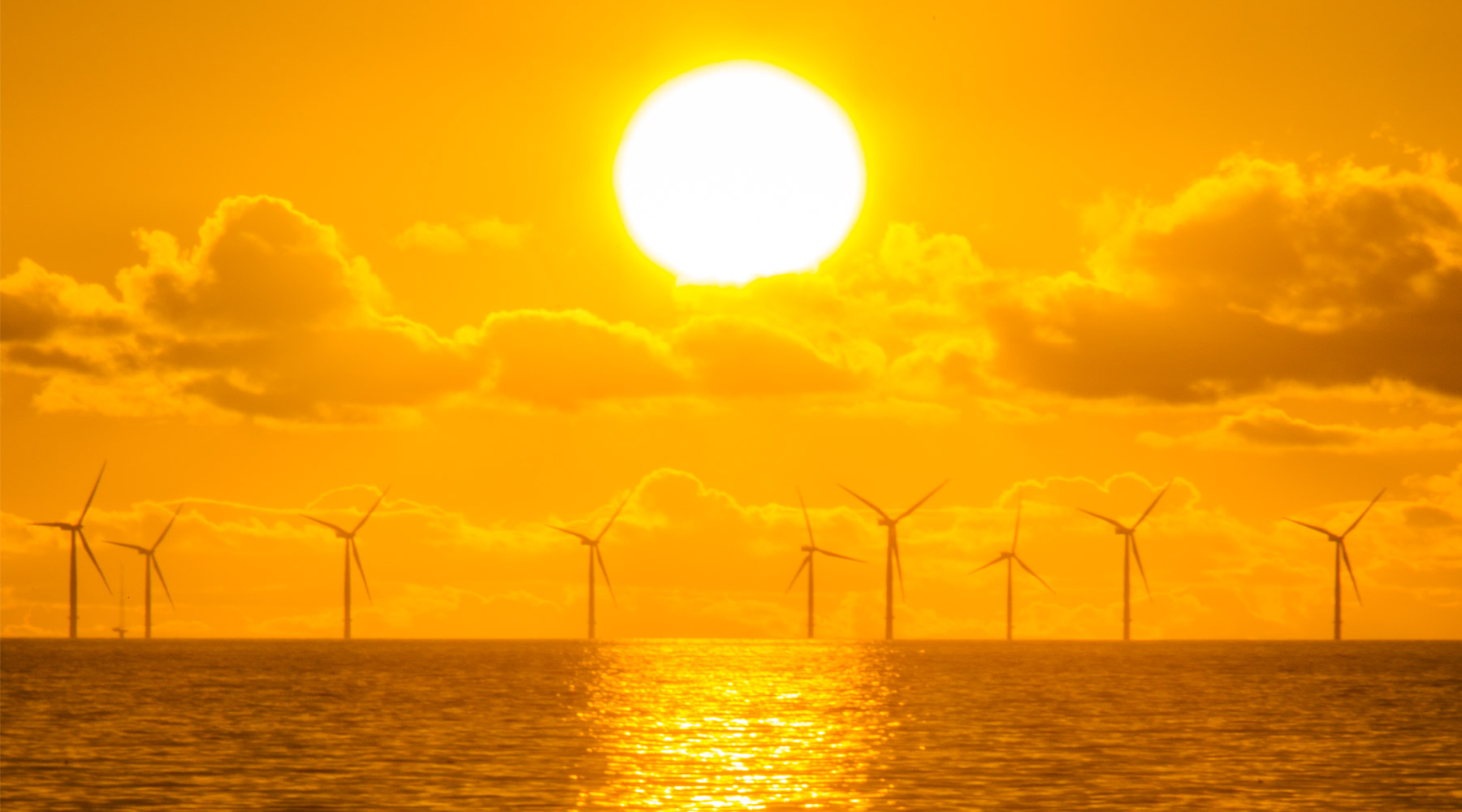

The unimaginable is now possible: 100% renewable energy. We can't settle for less.
August 22, 2017 | September Cover Story
The knock on environmentalists is that they’ve been better at opposing than proposing. Sure, being against overheating the planet or melting the ice caps should probably speak for itself—but it doesn’t give us a means. So it’s important news that the environmental movement seems to be rallying round a new flag. That standard bears a number: 100 percent.
It’s the call for the rapid conversion of energy systems around the country to 100 percent renewable power—a call for running the United States (and the world) on sun, wind and water. What Medicare for All is to the healthcare debate, or Fight for $15 is to the battle against inequality, 100% Renewable is to the struggle for the planet’s future. It’s how progressives will think about energy going forward—and though it started in northern Europe and Northern California, it’s a call that’s gaining traction outside the obvious green enclaves. In the last few months, cities as diverse as Atlanta and Salt Lake have taken the pledge.
No more half-measures. Barack Obama drove environmentalists crazy with his “all-of-the-above” energy policy, which treated sun and wind as two items on a menu that included coal, gas and oil. That is not good enough. Many scientists tell us that within a decade, at current rates, we’ll likely have put enough carbon in the atmosphere to warm the Earth past the Paris climate targets. Renewables—even the most rapid transition—won’t stop climate change, but getting off fossil fuel now might (there are no longer any guarantees) keep us from the level of damage that would shake civilization.
In any event, we no longer need to go slow: In the last few years, engineers have brought the price of renewables so low that, according to many experts, it would make economic sense to switch over even if fossil fuels weren’t wrecking the Earth. That’s why the appeal of 100% Renewable goes beyond the Left. If you pay a power bill, it’s the common-sense path forward.

To understand why it took a while to get to this point, consider the solar panel. We’ve had this clever device since Bell Labs produced the first model in 1954. Those panels lost 94 percent of the solar energy in conversion and were incredibly expensive to produce, which meant that they didn’t find many uses on planet Earth. In space, however, they were essential. Buzz Aldrin deployed a solar panel on the moon not long after Apollo 11 touched down.
Improvements in efficiency and drops in price came slowly for the next few decades. (Ronald Reagan, you may recall, took down the solar panels Jimmy Carter had installed atop the White House.) But in 1998, with climate fears on the rise, a close election in Germany left the Social Democrats in need of an alliance with the Green Party. The resulting coalition government began moving the country toward renewable energy.
As German demand for solar panels and wind turbines grew, factories across China learned to make the panels ever more cheaply and the price of panels began to plummet, a freefall that continues to this day. Germany now has days where half its power is generated by the sun. In 2017, solar or wind power wins most competitive bids for electric supply: India just announced the closure of dozens of coal mines and the cancellation of plans for new coal-fired generating stations because the low cost of solar power was undercutting fossil fuel. Even in oil-rich Abu Dhabi, free power from the sun is impossible to resist, and massive arrays are going up amidst the oil fields.
One person who noticed the falling prices and improving technology early on was Mark Jacobson, director of Stanford University’s Atmosphere and Energy Program. In 2009, his team published a series of plans showing how the United States could generate all its energy from the sun, the wind and the falling water that produces hydropower. Two years later, Jacobson and a crew of co-conspirators—including actor Mark Ruffalo—launched the Solutions Project to move the idea out of academic journals and into the real world. The group has since published detailed plans for most of the planet’s countries. If you want to know how many acres of south-facing roof you can find in Alabama or how much wind blows across Zimbabwe, these are the folks to ask.
With each passing quarter, the 100 percent target is becoming less an aspirational goal and more the obvious solution. Hell, I spent the spring in some of the poorest parts of Africa where people—for the daily price of enough kerosene to fill a single lamp—were installing solar panels and powering up TVs, radios and LED bulbs. If you can do it in Germany and Ghana, you can do it in Grand Rapids and Gainesville.
Even 72 percent of Republicans want to “accelerate the development of clean energy.” That explains why, for example, the Sierra Club is finding dramatic success with its #ReadyFor100 campaign, which lobbies cities to commit to 100 percent renewable. Sure, the usual suspects, such as Berkeley, Calif., were quick to sign on. But by early summer the U.S. Conference of Mayors had endorsed the drive, and leaders were popping up in unexpected places. Columbia, S.C., Mayor Steve Benjamin put it this way: “It’s not merely an option now; it’s imperative.”
Environmental groups from the Climate Mobilization to Greenpeace to Food and Water Watch are backing the 100 percent target, differing mainly on how quickly we must achieve the transition, with answers ranging from one decade to around three. The right answer, given the state of the planet, is 25 years ago. The second best: as fast as is humanly possible. That means, at least in part, as fast as government can help make it happen. The market will make the transition naturally over time (free sunlight and wind is a hard proposition to beat), but time is the one thing we haven’t got, so subsidies, hard targets and money to help spread the revolution to the poorest parts of the world are all crucial.
That’s why it’s so significant that Sen. Bernie Sanders (I-Vt.) joined with Sen. Jeff Merkley (D-Ore.) in April to propose the first federal 100 percent bill. It won’t pass Congress this year—but as a standard to shape the Democratic Party agenda in 2018 and 2020, it’s critically important.
Congress, however, is not the only legislative body that matters in America. Earlier this year, for instance, the California State Senate passed—by a 2-1 margin—a bill that would take the world’s sixth-largest economy to 100 percent renewable by 2045. Last month, Gov. Jerry Brown, in a bid to recreate the spirit of the Paris climate talks, invited the world’s “sub-national” leaders—governors, mayors, regional administrators—to a San Francisco conference in September 2018.
“Look, it’s up to you and it’s up to me and tens of millions of other people to get it together,” Brown said, as he invited the world to his gathering.
That’s not to say that this fight is going to be easy. Fossil fuel corporations know they’re not the future, yet they’re determined to keep us stuck in the past. Energy Secretary Rick Perry, for example, recently ordered a “study” that, as Democratic senators have pointed out, is “a thinly disguised attempt to promote less economic electric generation technologies, such as coal” by trying to show that intermittent sources of power such as sun and wind make the grid unreliable.
That’s always been the trouble with renewables: The sun sets and the wind dies down. Indeed, one group of academics challenged Mark Jacobson’s calculations this spring partly on these grounds, arguing that unproven techniques of capturing and storing carbon from fossil fuel plants will likely be necessary, as well as continued reliance on nuclear power. Yet technology marches on. Elon Musk’s batteries work in Tesla cars, but scaled up they make it economically feasible for utilities to store the afternoon’s sun for the evening’s electric demand. In May, at an industry confab, one California utility executive put it this way: “The technology has been resolved. How fast do you want to get to 100 percent? That can be done today.”
Meanwhile, the Trump administration is threatening to impose massive tariffs on solar panels coming into the United States. This could dramatically drive up the price of new U.S. solar installations, and two-thirds of the new arrays expected to come online over the next five years might never be built.
Before that happens, however, the growth in new rooftop installations has already come to what the New York Times has called “a shuddering stop,” because of “a concerted and well-funded lobbying campaign by traditional utilities, which have been working in state capitols across the country to reverse incentives for homeowners.” Instead of cutting residents a break for helping solve the climate crisis, in state after state utility corporations—led by the American Legislative Exchange Council (ALEC) and the Edison Electric Institute (whose political advocacy efforts ratepayers actually underwrite)—are passing legislation that pre-empts “net-metering” laws, which let customers sell their excess power back to the grid. Energy consultant Nancy LaPlaca puts it this way: “Utilities have a great monopoly going and they want to keep it.”
It’s not just right-wing Republicans who oppose renewables. Democrats often support new fossil fuel schemes, in part because they are in thrall to the building trades unions for campaign support. Last fall, days after the mercenaries hired by the company behind the Dakota Access Pipeline sicced German shepherds on indigenous protesters, the AFL-CIO (which includes the powerful North America Building Trades Unions) issued a statement supporting the pipeline “as part of a comprehensive energy policy. … Pipeline construction and maintenance provides quality jobs.” Sure enough, Hillary Clinton refused to join Obama in trying to block the pipeline. And, of course, Donald Trump approved the project early in his presidency, shortly after a cheerful meeting with the heads of the building trades unions. The first oil flowed through the pipeline the same afternoon that Trump pulled America out of the Paris climate accord.

That means, of course, that renewables advocates need to emphasize the jobs that will be created as we move toward sun and wind. Already, more Americans are employed in the solar industry than in coal fields, and the conversion is only just beginning. Sanders and Merkley’s federal 100 percent bill, beyond its generous climate benefits, is expected to produce 4 million new jobs over the coming decades.
And since those jobs aren’t always going to be in the same places as the fossil fuel ones they replace, renewable advocates must also demand a just transition for displaced workers. Labor Network for Sustainability (LNS) is a pro-climate and pro-labor group advocating that such workers get a deal like the 1944 G.I. Bill: three years of full wages and benefits, four years of education and retraining, and job placement in community economic development programs. This, by the way, is also a strong reason for a robust social safety net—revolutions come with losers as well as winners.
Environmental justice advocates are also quick to point out that renters and low-income homeowners need to share the economic benefits of the renewables revolution. In Brooklyn, N.Y., and Fresno, Calif., groups like UPROSE and Green for All are working on local solar projects to provide residents with clean energy and good jobs.
Jacqueline Patterson, who heads the NAACP’s environmental justice work, notes that low-income communities need to be cushioned from any cost increases as the market shifts over. “For those communities ‘just transition’ means their bills don’t fluctuate upwards.” In the best of worlds, she adds, “They’re not just a consumer writing a check every month, but they see now a chance to own part of that infrastructure.”
In June, the philanthropic Wallace Global Fund awarded the Standing Rock Sioux a $250,000 prize plus up to a $1 million investment to build renewable energy infrastructure on the reservation, a fitting commemoration to the bravery of water protectors who tried to hold the Dakota pipeline at bay. And a reminder that private foundations will need to play a role in this transition as well.
The political battle for renewables will be hard-fought. In January, the New York Times reported that the Koch brothers have begun to aggressively (and cynically) court minority communities, arguing that they “benefit the most from cheap and abundant fossil fuels.” Their goal is not only to win black voters to the GOP’s energy program, but to stall renewables in majority-black-and-brown cities like Richmond, Calif.
America’s twisted politics may slow the transition to renewables, but other countries are now pushing the pace. In June, for instance, China’s Qinghai Province—a territory the size of Texas—went a week relying on 100 percent renewable energy, a test of grid reliability designed to show that the country could continue its record-breaking pace of wind and solar installation.
China’s not alone. One Friday in April, Great Britain, for the first time since the launch of the Industrial Revolution, managed to meet its power demands without burning one lump of coal. Since 2014, solar production has grown six-fold in Chile, where Santiago’s Metro system recently became the first to run mostly on sun. Holland said this winter that its train system was now entirely powered by the wind, and, in a memorable publicity stunt, strapped its CEO to the blade of a spinning windmill to drive the point home.
These are all good signs—but, set against the rapid disintegration of polar ice caps and the record global temperatures each of the last three years, they still amount to too little. It’s going to take a deeper level of commitment—including turning the U.S. government from an obstacle to an advocate over the next election cycles. That’s doable precisely because the idea of renewable energy is so popular.
“There are a few reasons why 100% Renewable is working—why it’s such a powerful idea,” says Michael Brune, executive director of the Sierra Club. “People have agency, for one. People who are outraged, alarmed, depressed, filled with despair about climate change—they want to make a difference in ways they can see, so they’re turning to their backyards. Turning to their city, their state, their university. And, it’s exciting—it’s a way to address this not just through dread, but with something that sparks your imagination.”
Sometimes, Brune says, all environmentalists have to rally together to work on the same thing, such as Keystone XL or the Paris accord. “But in this case the politics is as distributed as the solution. It’s people working on thousands of examples of the one idea.” An idea whose time has come. 
wrote the first book for a general audience on climate change (The End of Nature, 1989) and co-founded 350.org, a global grassroots climate organization. He is the recipient of the Gandhi Peace Award and the Right Livelihood Award, and is Schumann Distinguished Scholar in environmental studies at Middlebury College in Vermont.
Above: The sun sets over an offshore wind farm, near Walney Island in the U.K. This is slated to become the largest offshore wind farm in the world. Photo by Ashley Cooper / Barcroft Images / Barcroft Media via Getty Images.
Want more independent news and analysis? Subscribe to the free In These Times weekly newsletter:
